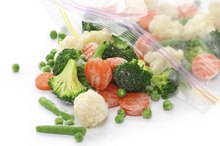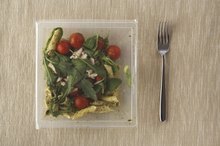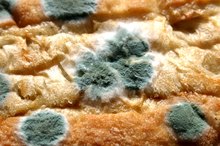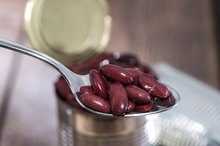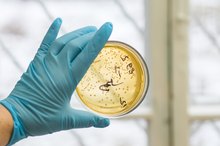Bacteria That Grow in the Refrigerator
The environment inside a refrigerator usually creates an inhospitable environment for many bacteria. But other bacteria are able to grow at cold temperatures, preferring some food hosts over others, such as poultry, eggs, milk and meat. Some bacteria make their presence known by covering food with unappetizing colors and fuzzy growths. Other bacteria pose health threats without any visible evidence to tip their hand.
Cold-Tolerant Bacteria
A refrigerator does not kill most food-borne bacteria. The purpose of storing food in a refrigerator is simply to extend the shelf life of perishable food. Cold temperatures stop the growth of some bacteria, imposing dormancy on them until temperatures warm up. These bacteria resume growing when frozen food is thawed or when refrigerated food reaches temperatures above 40 degrees Fahrenheit, which is the suggested setting for your refrigerator. Other bacteria are more tolerant to cold and do not become dormant in the refrigerator, but continue growing on their food hosts.
- A refrigerator does not kill most food-borne bacteria.
- These bacteria resume growing when frozen food is thawed or when refrigerated food reaches temperatures above 40 degrees Fahrenheit, which is the suggested setting for your refrigerator.
Spoilage Bacteria
How to Prevent Bacterial Growth in Food
Learn More
Spoilage bacteria cause unsightly growths in a rainbow of colors on refrigerated foods. Not only is the food unattractive, but it typically develops bad tastes and smells. In spite of its dangerous-looking appearance, spoilage bacteria likely won’t make you sick. Lactic-acid bacteria, which include Lactobacillus, Pediococcus and Oenococcus species are responsible for producing yogurt. But under low temperatures, such as in a refrigerator, these same bacteria are the primary culprits that cause food spoilage. Lactic-acid bacteria may cause foods to taste liver-like or cheesy, and they may cause meat to turn green.
- Spoilage bacteria cause unsightly growths in a rainbow of colors on refrigerated foods.
- But under low temperatures, such as in a refrigerator, these same bacteria are the primary culprits that cause food spoilage.
Pathogenic Bacteria
Unlike spoilage bacteria, pathogenic bacteria don’t leave calling cards of their presence, such as fuzzy growths and rainbow colors. They lurk unseen on refrigerated food without even a malodorous hint or funny taste. These are the dangerous bacteria -- disease-causing organisms that can make you sick.
Food Safety
Side Effects of Eating Thawed Then Refrozen Food
Learn More
A refrigerator’s internal temperature is critical to food safety 2. If your refrigerator is not equipped with a thermometer, use an appliance thermometer to monitor its internal temperature. Maintain the temperature between 34 and 40 degrees F, although colder temperatures prevent food spoilage better. Crowded refrigerators have areas that may be warmer than the thermometer reading because of poor air circulation, so pack the shelves loosely. Inspect the door seal to verify it forms a tight fit with the refrigerator body so there is no heat gain inside your appliance.
- A refrigerator’s internal temperature is critical to food safety 2.
- Inspect the door seal to verify it forms a tight fit with the refrigerator body so there is no heat gain inside your appliance.
Related Articles
References
Writer Bio
Victoria Lee Blackstone is a horticulturist and a professional writer who has authored research-based scientific/technical papers, horticultural articles, and magazine and newspaper articles. After studying botany and microbiology at Clemson University, Blackstone was hired as a University of Georgia Master Gardener Coordinator. She is also a former mortgage acquisition specialist for Freddie Mac in Atlanta, GA.

